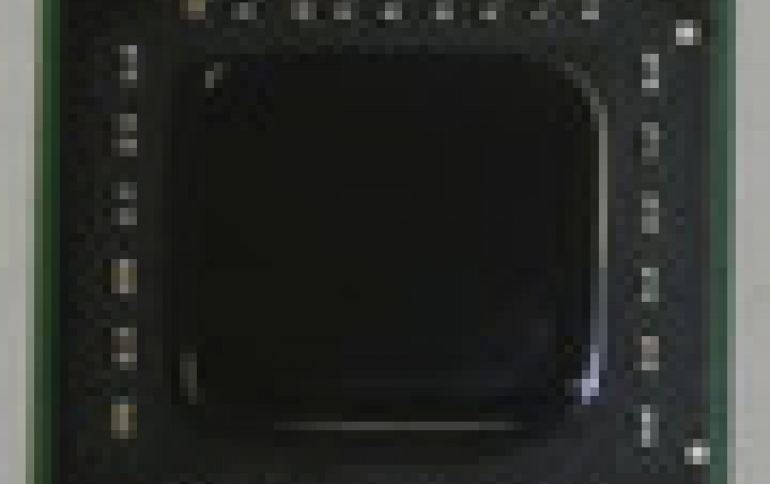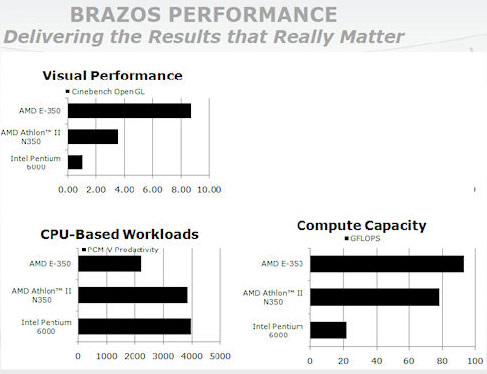
AMD Officially Launches Fusion Chips And Radeon HD 6000M GPus For Notebooks
AMD, at Consumer Electronics Show (CES) 2011, launched a new class of accelerated processor that combines with strong compute capabilities - the AMD Fusion family of accelerated processing units (APUs) in a single die design.
The company also introduced its next generation mobile graphics technology, the AMD Radeon HD 6000M series, delivering AMD's highest performing notebook graphics for those who want to experience games, entertainment, and productivity on the go.
Fusion Era begins
AMd claims that the new accelerated processor combines more compute capabilities than any processor in the history of computing. The AMD Fusion Family of Accelerated Processing Units (APUs) incorporate - in a single die design - multi-core CPU (x86) technology, a DirectX 11-capable discrete-level graphics and parallel processing engine, a dedicated high-definition video acceleration block, and a high-speed bus that speeds data across the differing types of processor cores within the design. New generations of desktop, notebook and HD netbooks are now available based on AMD Fusion APUs at affordable price points. Tablets and embedded designs based on AMD Fusion APUs are expected be available later in Q1 2011. AMD claims that the new range of products features include stutter-free HD video playback, breakthroughs in computational horsepower to handle the most demanding applications, DirectX 11-capable graphics and all-day battery life.

AMD expects manufacturers Acer, Asus, Dell, Fujitsu, HP, Lenovo, MSI, Samsung, Sony and Toshiba to announce plans to deliver AMD Fusion APU-based systems at mainstream price points.
"We believe that AMD Fusion processors are, quite simply, the greatest advancement in processing since the introduction of the x86 architecture more than forty years ago," said Rick Bergman, senior vice president and general manager, AMD Products Group. "In one major step, we enable users to experience HD everywhere as well as personal supercomputing capabilities in notebooks that can deliver all-day battery life.1 It's a new category, a new approach, and opens up exciting new experiences for consumers."
The VISION Engine from AMD, a set of capabilities unique to all AMD Fusion APU-powered PCs offer DirectX 11-capable graphics, parallel processing to speed application performance, the UVD3 video acceleration block found in the new AMD Radeon HD 6800 Series GPUs as well as graphics driver capabilities updated on a monthly basis to continuously improve visual performance.
Much of a computing experience is linked to software and, until now, software developers have been held back by the independent nature in which CPUs and GPUs process information. However, AMD Fusion APUs remove this obstacle and allow developers to take full advantage of the parallel processing power of a GPU - more than 500 GFLOPs for the upcoming A-Series "Llano" APU - thus bringing supercomputer-like performance to every day computing tasks.
Additionally, AMD Fusion technology enables all-day battery life - 10 hours or more. The new power-saving features present in the single-chip design extend the time between plug-ins, even when enjoying HD content.
E-Series, C-Series and A-Series APUs
The 2011 low power platform (formerly codenamed "Brazos") is available beginning today in two APU variations: E-Series and C-Series. These APUs feature the new x86 CPU core codenamed "Bobcat".



AMD said that the 2011 mainstream platform is primarily intended for performance and mainstream notebooks and mainstream desktops. It will feature the 32nm die A-Series "Llano" APU, which includes up to four x86 cores and a DirectX 11-capable discrete-level GPU, and is scheduled to ship in the first half of 2011 and appear in products mid-year.

Software and hardware companies will support the AMD Fusion Family of Accelerated Processing Units (APUs). To access the capabilities of the APU architecture, AMD collaborates with a variety of middleware and tools providers to offer software development kits that facilitate the use of industry-standard application programming interfaces (APIs) such as OpenCL, OpenGL, Direct2D and DirectCompute. AMD further supports the optimization of software for AMD Fusion APUs with AMD Accelerated Parallel Processing (APP) technology, which helps developers more easily tap into the combined power of the GPU and CPU to accelerate existing applications and create new possibilities in software.
Many companies will be demonstrating the computing experiences enabled by AMD technology including AMD Fusion APUs at the Consumer Electronics Show (CES) this week in the Wired showcase sponsored by AMD (Grand Lobby), as well as in the AMD Technology Showcase. These include Adobe, ArcSoft, Corel, CyberLink, DivX, Microsoft and Windows) and Roxio.
AMD motherboard partners are also innovating around the launch of the first AMD Fusion APUs, as original design manufacturers (ODMs), including ASUS, Gigabyte, MSI and Sapphire, have announced integrated APU/motherboard products for the first PC platforms featuring AMD Fusion APUs.



AMD Radeon HD 6000M series
AMD also today introduced its next generation mobile graphics technology, the AMD Radeon HD 6000M series. The new DirectX 11-capable mobile graphics processors have been designed to deliver high performance in notebooks.
The new GPUs offer up to 1.3 teraFLOPS of compute power on up to six displays using AMD Eyefinity technology, feature the AMD HD3D technology for stereo 3D entertainment as well as AMD EyeSpeed technology for improved video and application performance.
Notebooks featuring the new graphics technology are previewed at the 2011 Consumer Electronics Show (CES).
Fusion Era begins
AMd claims that the new accelerated processor combines more compute capabilities than any processor in the history of computing. The AMD Fusion Family of Accelerated Processing Units (APUs) incorporate - in a single die design - multi-core CPU (x86) technology, a DirectX 11-capable discrete-level graphics and parallel processing engine, a dedicated high-definition video acceleration block, and a high-speed bus that speeds data across the differing types of processor cores within the design. New generations of desktop, notebook and HD netbooks are now available based on AMD Fusion APUs at affordable price points. Tablets and embedded designs based on AMD Fusion APUs are expected be available later in Q1 2011. AMD claims that the new range of products features include stutter-free HD video playback, breakthroughs in computational horsepower to handle the most demanding applications, DirectX 11-capable graphics and all-day battery life.

AMD expects manufacturers Acer, Asus, Dell, Fujitsu, HP, Lenovo, MSI, Samsung, Sony and Toshiba to announce plans to deliver AMD Fusion APU-based systems at mainstream price points.
"We believe that AMD Fusion processors are, quite simply, the greatest advancement in processing since the introduction of the x86 architecture more than forty years ago," said Rick Bergman, senior vice president and general manager, AMD Products Group. "In one major step, we enable users to experience HD everywhere as well as personal supercomputing capabilities in notebooks that can deliver all-day battery life.1 It's a new category, a new approach, and opens up exciting new experiences for consumers."
The VISION Engine from AMD, a set of capabilities unique to all AMD Fusion APU-powered PCs offer DirectX 11-capable graphics, parallel processing to speed application performance, the UVD3 video acceleration block found in the new AMD Radeon HD 6800 Series GPUs as well as graphics driver capabilities updated on a monthly basis to continuously improve visual performance.
Much of a computing experience is linked to software and, until now, software developers have been held back by the independent nature in which CPUs and GPUs process information. However, AMD Fusion APUs remove this obstacle and allow developers to take full advantage of the parallel processing power of a GPU - more than 500 GFLOPs for the upcoming A-Series "Llano" APU - thus bringing supercomputer-like performance to every day computing tasks.
Additionally, AMD Fusion technology enables all-day battery life - 10 hours or more. The new power-saving features present in the single-chip design extend the time between plug-ins, even when enjoying HD content.
E-Series, C-Series and A-Series APUs
The 2011 low power platform (formerly codenamed "Brazos") is available beginning today in two APU variations: E-Series and C-Series. These APUs feature the new x86 CPU core codenamed "Bobcat".



AMD said that the 2011 mainstream platform is primarily intended for performance and mainstream notebooks and mainstream desktops. It will feature the 32nm die A-Series "Llano" APU, which includes up to four x86 cores and a DirectX 11-capable discrete-level GPU, and is scheduled to ship in the first half of 2011 and appear in products mid-year.

Software and hardware companies will support the AMD Fusion Family of Accelerated Processing Units (APUs). To access the capabilities of the APU architecture, AMD collaborates with a variety of middleware and tools providers to offer software development kits that facilitate the use of industry-standard application programming interfaces (APIs) such as OpenCL, OpenGL, Direct2D and DirectCompute. AMD further supports the optimization of software for AMD Fusion APUs with AMD Accelerated Parallel Processing (APP) technology, which helps developers more easily tap into the combined power of the GPU and CPU to accelerate existing applications and create new possibilities in software.
Many companies will be demonstrating the computing experiences enabled by AMD technology including AMD Fusion APUs at the Consumer Electronics Show (CES) this week in the Wired showcase sponsored by AMD (Grand Lobby), as well as in the AMD Technology Showcase. These include Adobe, ArcSoft, Corel, CyberLink, DivX, Microsoft and Windows) and Roxio.
AMD motherboard partners are also innovating around the launch of the first AMD Fusion APUs, as original design manufacturers (ODMs), including ASUS, Gigabyte, MSI and Sapphire, have announced integrated APU/motherboard products for the first PC platforms featuring AMD Fusion APUs.



AMD Radeon HD 6000M series
AMD also today introduced its next generation mobile graphics technology, the AMD Radeon HD 6000M series. The new DirectX 11-capable mobile graphics processors have been designed to deliver high performance in notebooks.
The new GPUs offer up to 1.3 teraFLOPS of compute power on up to six displays using AMD Eyefinity technology, feature the AMD HD3D technology for stereo 3D entertainment as well as AMD EyeSpeed technology for improved video and application performance.
Notebooks featuring the new graphics technology are previewed at the 2011 Consumer Electronics Show (CES).
HD 6900M |
HD 6800M Series |
HD 6700M/HD 6600M Series |
HD 6500M Series |
HD 6400M Series |
HD 6300M Series |
|
Engine clock speed |
580-680 MHz |
575-675 MHz |
500-725 MHz |
500-650 MHz |
480-800 MHz |
500-750 MHz |
Processing power (single precision) |
1.1-1.3 TeraFLOPS |
920-1080 GigaFLOPS |
480-696 GigaFLOPS |
400-520 GigaFLOPS |
153-256 GigaFLOPS |
80-120 GigaFLOPS |
Polygon throughput |
580-680M polygons/sec |
575-675M polygons/sec |
500-725M polygons/sec |
500-650M polygons/sec |
120-200M polygons/sec |
125-187.5M polygons/sec |
Data fetch rate (32-bit) |
111-130 billion fetches/sec |
92-108 billion fetches/sec |
48-69.6 billion fetches/sec |
40-52 billion fetches/sec |
15.36-25.6 billion fetches/sec |
16-24 billion fetches/sec |
Texel fill rate (bilinear filtered) |
27.84-32.64 Gigatexels/sec |
23-27 Gigatexels/sec |
12-17.4 Gigatexels/sec |
10-13 Gigatexels/sec |
3.84-6.4 Gigatexels/sec |
4-6 Gigatexels/sec |
Pixel fill rate |
18.56-21.76 Gigapixels/sec |
9.2-10.8 Gigapixels/sec |
4-5.8 Gigapixels/sec |
4-5.2 Gigapixels/sec |
1.92-3.2 Gigapixels/sec |
2-3 Gigapixels/sec |
Anti-aliased pixel fill rate |
74.24-87.04 Gigasamples/sec |
36.8-43.2 Gigasamples/sec |
16-23.2 Gigasamples/sec |
16-20.8 Gigasamples/sec |
7.68-12.8 Gigasamples/sec |
8-12 Gigasamples/sec |
Memory clock speed |
900 MHz |
900-1000 MHz |
800-900 MHz GDDR5 or DDR3 |
900 MHz GDDR5 or DDR3 |
800-900 MHz GDDR5 or DDR3 |
800-900 MHz |
Memory data rate |
3.6 Gbps |
3.6-4.0 Gbps |
3.2-3.6 Gbps GDDR5 or 1.6-1.8 Gbps DDR3 |
3.6 Gbps (GDDR5) or 1.8 Gbps (DDR3) |
3.2 Gbps GDDR5 or 1.6-1.8 Gbps DDR3 |
1.6-1.8 Gbps |
Memory bandwidth |
115.2 GB/sec |
57.6-64 GB/sec |
51.2-57.6 GB/sec (GDDR5) or 25.6-28.8 GB/sec (DDR3) |
57.6 GB/sec (GDDR5) or 28.8 GB/sec (DDR3) |
25.6 GB/sec (GDDR5) or 12.8-14.4 GB/sec (DDR3) |
12.8-14.4 GB/sec |
TeraScale 2 Unified Processing Architecture |
|
|
|
|
|
|
Memory interface |
GDDR5 |
GDDR5 |
GDDR5/DDR3 |
GDDR5/DDR3 |
GDDR5/DDR3 |
DDR3 |
Bus interface |
PCI Express 2.1 x16 |
|||||





















